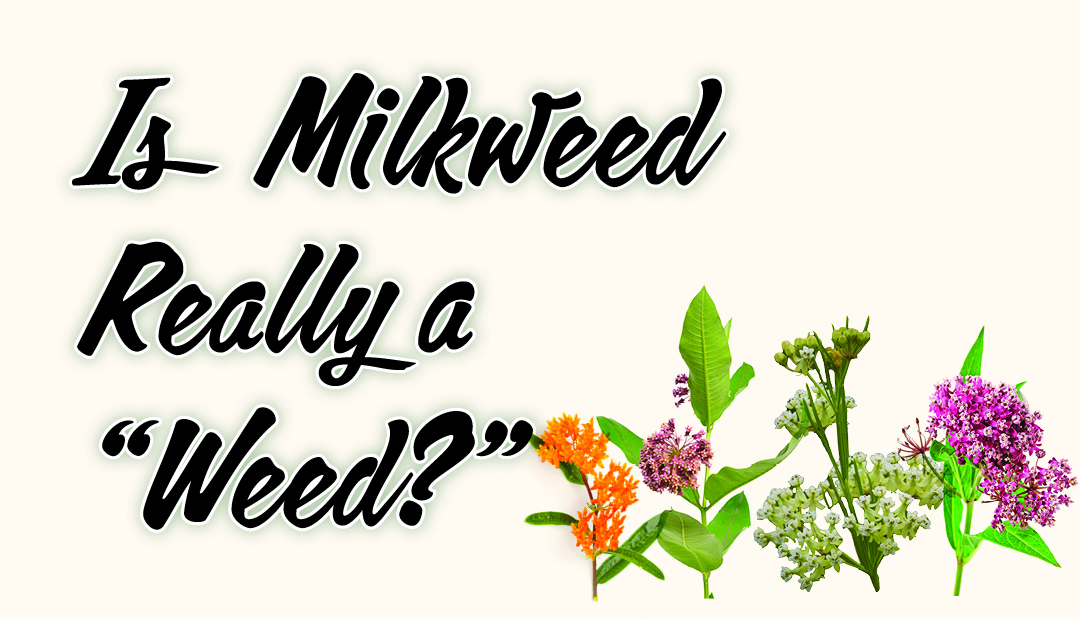Submitted by PAM VARGA, Sahli Park Manager
What exactly is a “weed”? From a gardener’s point of view, a weed is simply a plant growing where you don’t want it. Ralph Waldo Emerson, an American poet and philosopher who lived from 1803 to 1882, said that a weed is a plant whose virtues have not been discovered. Many plants we call weeds have great ecological value and have been found to be useful in medicine and industry. Many weeds actually have beautiful flowers and have become popular in landscaping. So, is milkweed an unwanted plant, or does it have many virtues?
There are about 200 species of Milkweed around the world, 140 in North and South America, and seven native to Pennsylvania. At Sahli Nature Park, you will find 4 different species.
Common Milkweed (Asclepias syriaca) grows 3 – 5 feet tall and has oval shaped leaves about 6 – 8 inches long. From June to August, Common Milkweed has clusters of very fragrant pinkish blossoms. This milkweed can grow in almost any kind of soil and can be found in farm fields, along roadsides, and in wild meadows. It grows in colonies of single stemmed plants.
Swamp Milkweed (Asclepias incarnata) also called Rose Milkweed. Its leaves are more narrow and pointed than Common Milkweed. It’s clusters of flowers are a darker pink, blooming from June to October. Swamp Milkweed doesn’t have to grow in a swamp, but it prefers wet or moist soil. It grows in clumps and makes a fine garden plant.
The flowers of Butterfly Weed (Asclepias tuberosa) are brilliant orange. This shorter milkweed grows to 2 to 3 feet tall and blooms from May to September. The leaves are long, narrow, and pointed. The bright orange flowers are a great addition to your garden.
Whorled Milkweed (Asclepias verticillate) has thin grass-like leaves that grow in a spiral pattern around the stem. Small flat topped clusters of dainty white flowers bloom from May to September. Because it is shorter, Whorled Milkweed makes a nice border plant.
In late summer and early fall, the milkweed flowers die and give way to bumpy football shaped green seed pods. Each pod contains up to 200 seeds. Each seed is attached to a bit of fluff called floss. When the pods ripen and split open, the floss catches the wind, carrying the seeds to a new place to grow.
Native Milkweeds play a very important part in the ecosystems where they are found. Over 450 species of insects feed on different parts of the plant. Butterflies, bees, moths, wasps, flies, beetles and even Hummingbirds feed on the pollen and nectar in the blossoms. Beetles, bugs, aphids and caterpillars feed on the stems and leaves. Ants feed on the honey dew excreted by aphids that feed on the stems, and predatory ladybugs eat the aphids.Other predatory insects and spiders feed on the plant eating insects. Milkweed leaves are the only food for Monarch butterfly caterpillars. One of the reasons why the Monarch population has declined by 59% this year is the loss of Milkweed. On a sunny day when the flowers are in bloom and the air is filled with their sweet scent, take time to explore a patch of Milkweed and you’ll be amazed at the variety of life you can find there.
From the 1800s until the 1940s, milkweed was highly valued by beekeepers. Honey made by bees from Milkweed nectar was thought to have an excellent fruity taste. Milkweed honey is still sold today.
Not only does Milkweed have an ecological value, but it is the unsung hero of World War II. Prior to the war, the United States used fibers from the Kapok tree in Asia to fill life jackets. However, the war cut off the supply. German U-boats patrolling the Atlantic coast of America sank over 230 ships, killing 5,000 sailors and passengers. Crews piloting bombers flew from England over the North Sea to Europe. Much of the fighting took place over and in the Pacific Ocean. Many planes were damaged or destroyed, crashing into the water. The chances of the crew surviving a crash were only 6%. Dr. Boris Berkman, a business man and inventor, discovered that the fluffy floss attached to milkweed seeds could be used in place of kapok fibers. In fact, the Milkweed floss was as warm as wool, light in weight and extremely bouyant. A life jacket filled with floss could keep a man afloat for 40 hours. Twenty pounds of floss were needed to fill one life jacket that could save the life of a service man.
The problem was that Milkweed was not an agricultural product. The plants were scattered over farm fields, meadows and countrysides. How could enough be collected to fulfill the wartime need? Dr. Berkman and the military leaders launched a campaign to recruit school children, scout groups and community organizations to collect Milkweed seed pods. Posters urged school children to help save the lives of their fathers, brothers and sisters by collecting milkweed pods. Citizens were urged to contribute directly to victory and save the lives of American servicemen by collecting milkweed pods. The slogan “Two bags save a life” referred to the fact that two bags of Milkweed seeds were needed to make one life jacket. School children were bussed to fields were Milkweed could be found and collected bags of pods. Prizes were offered and 20 cents a bag was paid. In 1944, 90,000 pounds of milkweed were dried and sent to Petroskey Fair Grounds in Michigan to be processed. By the end of the war, 11 million pounds had been collected by an army of school children and citizens. More than 1.2 million life vests were made, saving the lives of thousands of service men and women.
So, is Milkweed really a pesky “weed”? I don’t think so, and perhaps now you don’t think so either.







